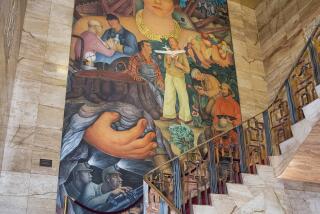California missions: The quest to cast a spotlight on the darker side of the missionaries’ march
On different days more than 200 years ago, an Ohlone man and woman named Poylemja and Jocbocme stepped up to be baptized Faustino and Obulinda by the Spanish friars at the Mission Dolores in San Francisco. The move put them between two cultures at a perilous time.
By 1807, both were dead and buried at the same mission. All these years later, at least two of their descendants still straddle those two cultures.
One of them is Andrew Galvan, 59, now keeper of that mission’s history. He’s the mission curator, responsible for planning exhibits and recruiting guides to explain mission history, which some see as a march to enlightenment and some see as cultural genocide. (Here’s one example of the “genocide” perspective: bit.ly/1p2708c.)
Explore all of California’s 21 famed missions >>
Galvan, a Catholic who was hired by church leaders to do this half-time job in 2003, is the only descendant of California mission neophytes in such a position. His job, he likes to say, is to “put the Indians into the picture.”
The challenge, Galvan wrote in a letter last year, is that “most people associate mission history with the early Spanish invaders and uninvited occupiers. The Ohlones and other peoples who lived in the communities surrounding the missions are left out of the story or portrayed only as victims of forced labor.”
Galvan, who is the great-great-great-great-grandson of Faustino and Obulinda, grew up in the East Bay, got a bachelor’s degree in history at Cal State Hayward and co-owns an archaeological consulting firm that deals often with native remains. He has been to all the missions many times, and he sees them as a disastrous attempt to reach a noble goal — an attempt that historians say included forced labor, punishment by whipping, and the nightly locking of many women and female children into dormitories known as monjerios. (Details: bit.ly/1pnFAyT)
Since 2009, Galvan has been joined at Mission Dolores by his cousin Vincent Medina, who leads tours. Medina, 27, studies anthropology at Berkeley City College and blogs often (www.ohlone.tumblr.com) about his efforts to revive the Ohlones’ language, Chochenyo.
Together, they hope to help Mission Dolores find a way to display the names of the 5,700 native neophytes buried anonymously in the mission cemetery.
In their presentations, the two often emphasize that California’s native cultures are far from extinct. On and off the state’s dozens of reservations, Indian leaders are working to revive languages and customs, sometimes aided by revenues from the many reservation casinos that have opened in the last 35 years. Even though most missions do little or nothing to encourage them, Galvan said, many Native Americans continue to belong to the Catholic Church.
For all they share, however, Galvan and Medina still disagree on a central question. Medina says he sees Father Junípero Serra as the imperfect leader of an often “hurtful and catastrophic” institution — not a saint. Galvan, who studied in a seminary for several years and has a brother in the priesthood, has spent more than 35 years campaigning for Serra sainthood. (The California mission system founder has been beatified but not canonized.) Galvan calls Serra “a very, very good person in a very, very bad situation” — colonialism — and daily asks Serra to hear his prayers.
When school groups file through, Medina said, he often thinks back to when he was a fourth-grader, touring the San Jose mission while a guide told his class how happy the friendly, faithful, peaceful Indians were that the Spanish had brought them civilization. Even then, Medina said, he knew “that isn’t really true. ... That’s what drove me to work at the mission, to be able to talk about mission history from a more just and fair perspective, really focusing on native identity and the cultural perseverance.”
Medina sometimes cites author Deborah A. Miranda (“Bad Indians: A Tribal Memoir”), a Native American and professor who has asked: “Can you imagine teaching about slavery in the U.S. South while simultaneously requiring each child to lovingly construct a plantation model, complete with happy darkies in the fields, white masters, overseers with whips, and human auctions?” (For more: https://www.bit.ly/1vtLgIf)
As it happens, Medina has a little brother, Gabriel, who reached fourth grade last year and signed up to do a project on Mission San José.
With Medina helping, Gabriel decided to make a model of the mission under attack, portraying an event that happened in 1821. They bought tiny soldiers and painted them to look like Ohlone fighters. They used toothpicks for bows and arrows, orange cellophane for fire. The teacher gave Gabriel an A for creativity, Medina said, but wanted a chat with the boy to be sure he wasn’t advocating violence.
Not at all, Medina said. “We were trying to discuss something that isn’t often discussed.”
More to Read
Sign up for The Wild
We’ll help you find the best places to hike, bike and run, as well as the perfect silent spots for meditation and yoga.
You may occasionally receive promotional content from the Los Angeles Times.







